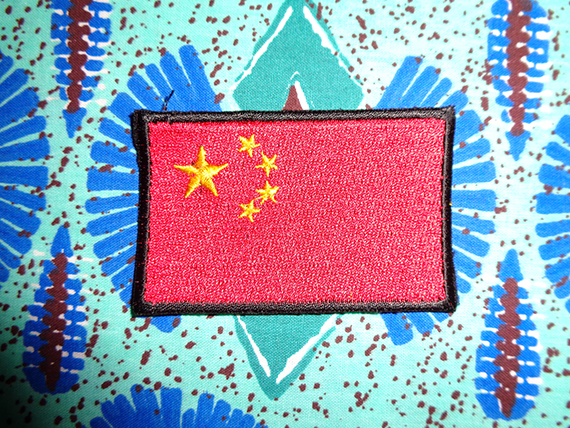
Mar-29-2020
China in Africa (2019): Facebook and Twitter as Part of Public Diplomacy
Alexandra Pinheiro*, Bruno Rodrigues*, Guilherme Soares*, Maria Matos*, Mariana Sequeira*, Mélanie Gonçalves*, Matilde Azevedo*, Sílvia Carneiro*, Jorge Marinho**
*Student attending the Applied Languages - Major in Business Relations Study Program / Languages and International Relations Study Program – University of Porto Faculty of Arts and Humanities (Portugal) / 2019-2020
**Research supervisor. Ph.D. in Communication Sciences, BA in International Journalism, Professor at the University of Porto (Portugal)
e-mail: marinho.mediaanalysis@gmail.com
Abstract
This article constitutes an analysis of public diplomacy developed by Chinese embassies in Africa, throughout 2019, over the Internet, most notably for Facebook and Twitter. This article also addresses the combination of Public Relations with Public Diplomacy, by focusing on aspects such as storytelling and engaging target audiences.
Keywords: Africa; China; social media; Public Diplomacy; Public Relations
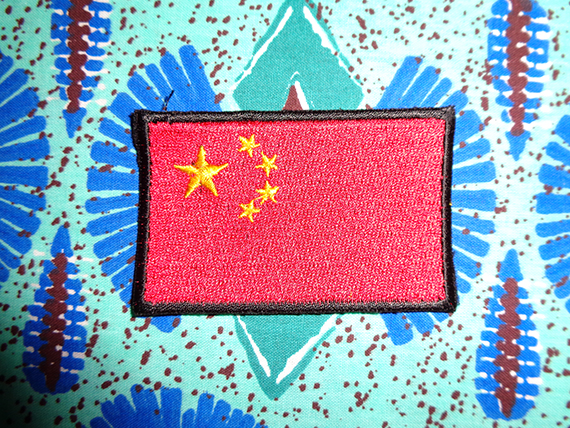
Figure 1: Chinese public diplomacy suited to the African cultural fabric
Introduction
(This article is based on research work conducted as part of the curricular unit of Public Relations under the Applied Languages / Major in Business Relations Study Program –University of Porto / Portugal Faculty of Arts and Humanities / 2019-2020).
This work focuses on the way Chinese embassies in Africa have conducted Public Diplomacy over the Internet for a relatively short time, chiefly using social media such as Facebook and Twitter. (This research excludes the Facebook of the Chinese Embassy in Algeria, due to language barriers).
The application of Public Relations to the field of Public Diplomacy also constitutes a line of research. The contents that Chinese diplomats have published on social media and African recipients’ feedback comprise aspects that are central to this article.
Methodology
This article is the result of bibliographical / webgraphical research, exclusive interviews with experts and content analysis, in quantitative and qualitative terms, with regard to China’s digital public diplomacy in Africa (2019).
Contextualization of the current Chinese presence in Africa
Javier Diéguez Suárez, Master in East Asia Studies – specializing in Contemporary China and International Relations – from Catalonia University (Spain), believes that the factors behind the Chinese Government’s growing interest in Africa are mostly of an economic nature (“Exclusive Interview with Javier Diéguez Suárez” December 1, 2019). According to this expert, “In the last few years, China’s biggest presence in Africa is due to economic interests: securing energy resources and raw materials… and opening African markets to Chinese goods and companies.” Along with these factors, there are others, of a political and social nature, which include the following, according to Issau Agostinho, researcher at the Centro de Estudos Africanos da Universidade do Porto / Portugal (CEAUP) [Centre of African Studies of Porto University (Portugal)]: “Not making cooperation contingent on human rights and non-interference in African internal affairs; ideological rapprochement among parties in power in China and Africa; and the interest of Africans in shifting away from the ‘neo-colonial paternalism’ of certain Western countries” (“Exclusive Interview with Issau Agostinho” November 20, 2019).
Within this framework of increasingly strengthening Sino-African relations, the strong ties forged via diplomacy have been vital, namely by setting up Embassies. Of Africa’s 54 independent states (United Nations Regional Groups of Member States), China has embassies in 53 of them (Chinese Embassies – Africa), with eSwatini (the former Swaziland) being the lone country without one, as it is the only African country that has diplomatic relations with Taiwan (Madowo January 14, 2019).
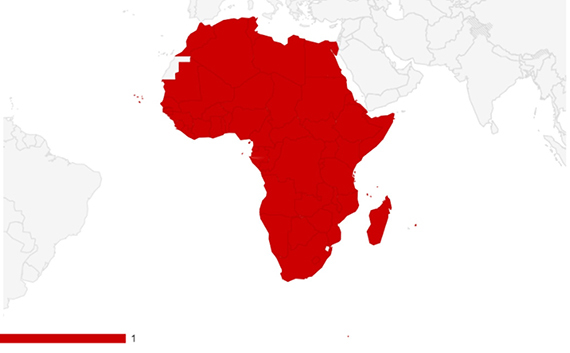
Figure 2 – Embassies of the People’s Republic of China in Africa that are covered by this research
The embassies’ role is pivotal in two aspects, according to Diéguez Suárez: “First of all, they coordinate, organize and secure visits from top Chinese officials to African countries (…) Moreover, they work to strengthen spaces for dialogue and cooperation between both parties” (“Exclusive Interview with Javier Diéguez Suárez” December 1, 2019).
Diplomacy and Public Relations
According to Isabel Ardions, professor at the Porto Accounting and Business School / The Polytechnic Institute of Porto (Portugal), “International Public Relations and public diplomacy (…) have followed in the footsteps of Public Relations in order to incorporate technological instruments, from the traditional mass media to social media, to making much greater use of storytelling concepts” (“Exclusive Interview with Isabel Ardions” December 1, 2019). In the case of the People’s Republic of China, public diplomacy can be examined in light of the following expression coined by President Xi Jinping, in 2016: “tell China’s stories well” – jianghao zhongguo gushi (Huang, Wang 2019).
It should be pointed out that the Chinese do not associate the term propaganda – xuanchuan – with negative connotations, as to them it is synonymous with Public Communication (Shi, Shi 2007) and Public Relations (Chen, Liu 2015 / Zhou 2010). Thus, public diplomacy is understood to be an extension of this xuanchuan. Nevertheless, Nuno Jorge da Silva, professor at the School of Communication and Media Studies, Lisbon (Portugal), underlines the need for “Diplomacy not to be a propagation instrument, but, rather, an element for building the country’s reputation. Diplomatic institutions need to strengthen the work of communicating with public relations professionals in order to create the value intended for every stakeholder” (“Exclusive Interview with Nuno Silva” December 3, 2019).
Realizing that the key for projecting a positive image of the country to the foreign public also includes state players’ ability to communicate, governments have sought to assimilate Public Relations strategies and techniques in their daily activity. From our standpoint, China's public diplomacy in Africa comprises aspects typical of Public Relations, such as creating and managing communication channels with the publics.
Digital Public Diplomacy
In 2013, two scholars from Renmin University of China School of Journalism and Communication (Beijing) published an article entitled “Public Diplomacy Meets Social Media: A Study of the U.S. Embassy’s Blogs and Micro-blogs” (Zhong, Lu December 2013). This material is also put into practice by Chinese diplomats in Africa. The year 2019 warranted our attention.
In the case of Africa, concern over public opinion has kept up with increased Chinese investment in that continent. With advances in technology, exercising these functions has overcome traditional public diplomacy barriers, while being carried out over the Internet, as well. This way, “The digital dimension has become one of the most important elements of any country’s public diplomacy, and China is no exception to the rule’’ (‘‘Exclusive Interview with Javier Diéguez Suárez’’ December 1, 2019). In this context, the websites of China’s Embassies in Africa, as well as their presence on social media, such as Facebook and Twitter, have proven to be pivotal in disseminating a positive image of the country to African publics.
Of the 53 Chinese embassies set up in Africa, only two do not have a website to date (November 2019): Burkina Faso (Ouagadougou) and Comoros (Moroni). These websites contain sections of tabs with links to external pages related to matters of interest to the Chinese government. Generally speaking, the vast majority of links forwards users to information agencies, most notably the following: China.org; Belt and Road; Chinaplus; Showchina; Xinhuanet; People’s Daily.

Figure 3 – External links available at the websites of the Embassies of the People’s Republic of China in Africa. Data gathered from the analysis of the Embassies’ websites (2019).
In a research of dominating sources, we concluded that they are all directly or indirectly controlled by the Chinese Government.
Most of the websites can be consulted in two languages [Chinese and another (English, French, Portuguese or Spanish)], thereby reflecting the government’s goal of communicating with foreign publics.
As for the presence of these diplomatic bodies on Facebook, this has been growing since 2014. Currently, 16 embassies have an official page; among these is that of Burkina Faso, which is active on Facebook despite not having a website.
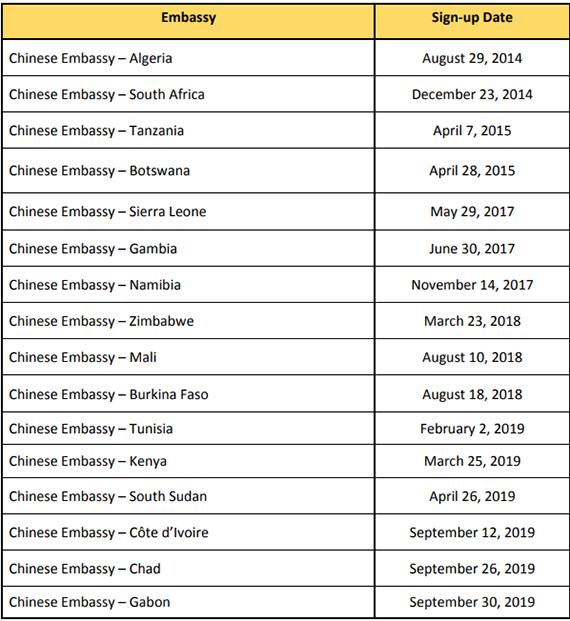
Table 1 - List of created Facebook pages for Embassies of the People’s Republic of China in Africa, shown in chronological order.
The main topics addressed throughout the 263 posts examined by our research include the following: Sino-African cooperation (41%); promoting China (29%) and diplomatic activities (9%). Even though China’s embassies in South Africa, Gabon, Kenya, South Sudan and Burkina Faso are very active on the aforementioned social media, the bulk of their activity boils down to sharing news from information agencies under Chinese government control, which amount to sources present on the websites.
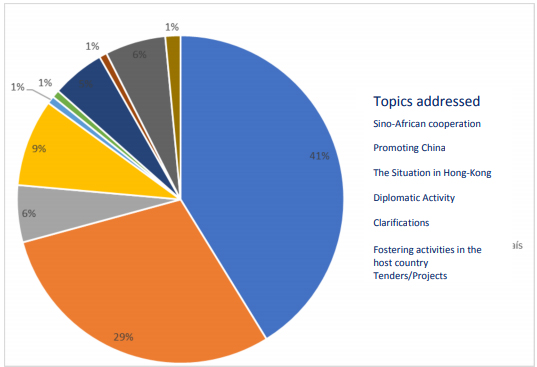
Figure 4 - Main contents of the 263 posts by Chinese Embassies in Africa on Facebook (Analysis conducted on October 22, 2019)
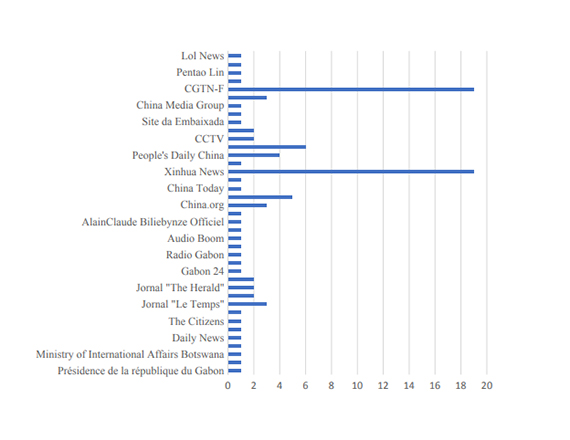
Figure 5 – Sources of the 263 analyzed Facebook posts by Chinese Embassies in Africa (Analysis conducted on October 22, 2019)
According to Nuno Silva, “the new digital platforms have been very minimally used by diplomatic institutions. For all intents and purposes, Facebook and Instagram are not one-directional, but, in many cases, they are treated this way, as showrooms of the institutions’ activities and with very little focus on creating a meaningful positive experience for anyone communicating with an embassy or a consulate” (“Exclusive Interview with Nuno Silva” December 3, 2019). From our vantage point, the style adopted by China’s embassies to relay their messages on Facebook is uniform, as it is shown to be unemotional and is merely a simple transfer of content typical of Web 1.0 to social media. Not adapting messages to the target public significantly limits the success of communication between the embassies and Africans, while hampering the creation of engagement with stakeholders. This is noticed in the disparity between the significant number of likes on the embassies’ Facebook pages and their average weekly interaction.
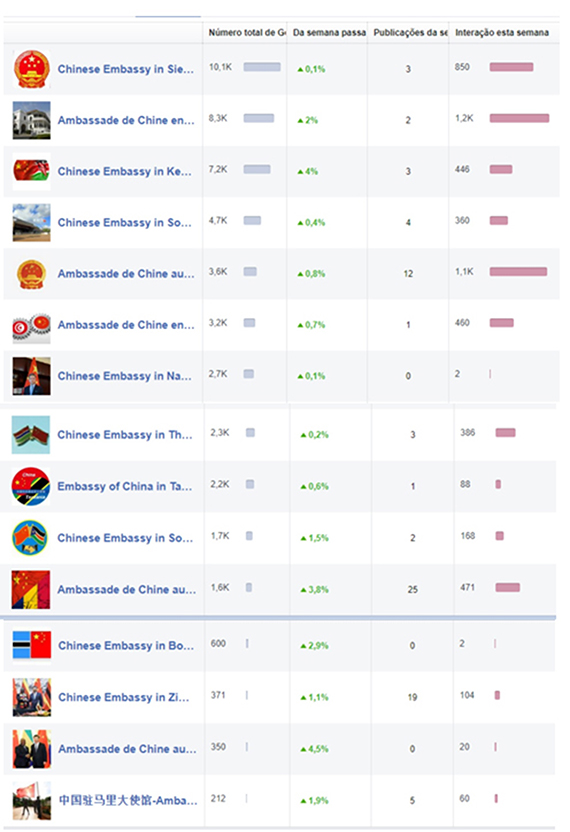
Figure 6 – Interactions recorded on the Facebook pages of the Embassies of the People’s Republic of Popular China in Africa, for a period of one week (December 1 to 8, 2019)
Table Header Key:
(a) – Total number of Likes (b) – From last week
(c) – Posts for the week (d) – Interaction this week
The positive or negative images will contribute toward the reputation of China’s embassies in Africa. Realizing this, Wang Yi, China’s Foreign Affairs Minister, during the ceremony marking the 70th anniversary of the founding of the People’s Republic of China, in September 2019, called for a greater fighting spirit, that is, for greater investment in promoting the Chinese narrative worldwide, via social media (Yi September 28, 2019).
In the case of Africa, ambassadors’ efforts to disseminate a positive image of China to the public on that continent have been noticed in the last few months, in advance of Wang Yi's request. One of the biggest novelties was the creation of a Twitter account by some Chinese ambassadors in Africa: Zheng ZhuQiang (Uganda), in March 2018; Guo Shaochun (Zimbabwe), in April 2019; Ling Songtian (South Africa) and Zhang Yiming (Namibia), in September 2019. Despite these being recent accounts, the ambassadors have regularly shared content, showing their willingness to more efficiently use social media in order to develop the “Chinese narrative.”
Our analysis features two diplomats: Guo Shaochun (Zimbabwe) and Ling Songtian (South Africa), given that they are noteworthy for the total number of Tweets – around two hundred, in just a few months. Furthermore, we need to highlight their relatively large number of followers: Guo Shaochun has 2191 followers (an average of 273 per month) and Ling Songtian with 1735 (around 578 per month), showing the potential of this platform for communicating with foreign publics. According to Olander and Mboya (August 16, 2019), from Fundan University, in Shanghai (China), this would have been unthinkable a few years ago, as diplomatic missions in Africa have always proven to be inaccessible, while ambassadors sought to do their utmost to keep far away from public events, from social media and from contact with the foreign public.
Chinese ambassadors are aware that the use of Web 2.0’s entire potential requires them to adapt their discourse to target publics, thereby allowing the conveyed message to circulate efficiently among its issuers (China) and its recipients (African publics). This way, Guo Shaochun, Chinese ambassador to Zimbabwe, has used a more informal language, befitting of social media, in his tweets in order to achieve greater proximity to his followers of interactions via Twitter, but rarely used in official communications.
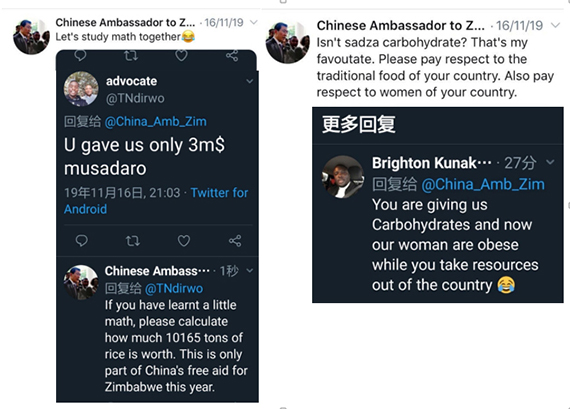
Figure 7 – Interactions of the Chinese Ambassador to Zimbabwe via Twitter (November 16, 2019).
By communicating with certain aspects that are known to the recipient, the Chinese ambassador leads the tweeting citizen to understand, in a language familiar to said recipient, the actual dimension of Chinese investment in the country, for instance.
In an examined post, ambassador Guo Shaochun shared the comment of a Zimbabwean national who accuses China of “filling the [Zimbabwean] people with carbohydrates, leaving [Zimbabwean] women obese.” Guo Shaochun once again turns to the very elements of Zimbabwean culture in response to the provocation, using, for example, sadza (a sort of purée prepared using white corn), a traditional dish in Zimbabwe, which, ironically, is a carbohydrate. This diplomat also takes advantage of the opportunity to highlight his personal liking of that dish, by showing the Zimbabwean public following him on Twitter how much he enjoys the country’s culture and cuisine. Along a parallel line, this ambassador’s Twitter has proven to be interesting in the way he has integrated emotional elements into his posts. An example of this is his sharing of photos he took of the streets of Harare, Zimbabwe’s capital, containing descriptions reflecting his admiration for the country’s beauty. In fact, one of those photos is used as his Twitter cover photo.

Figure 8 – Twitter posts by the Chinese Ambassador to Zimbabwe, September 30, 2019 and October 20, 2019
The approach used by Ling Songtian, China’s ambassador to South Africa, is similar to the one previously examined in several aspects. In a post dated October 7, 2019, the ambassador shared a photo of a street in Saint Petersburg, bearing the description, “It is so beautiful season and country. I love it and expect more people to share.”
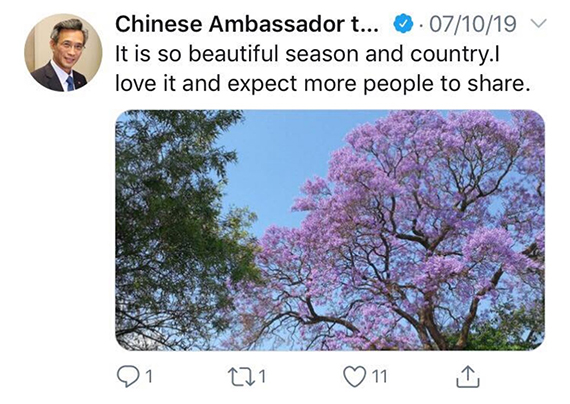
Figure 9 – Twitter Post by the Chinese Ambassador to South Africa, on October 7, 2019
Concurrently, the establishment of analogies between China and Zimbabwe on basic issues, such as the lack of water in certain regions, has constituted a way for China to draw closer to the people of Zimbabwe, whom it already regards as a “friend” [”Zimbabwean friends”].
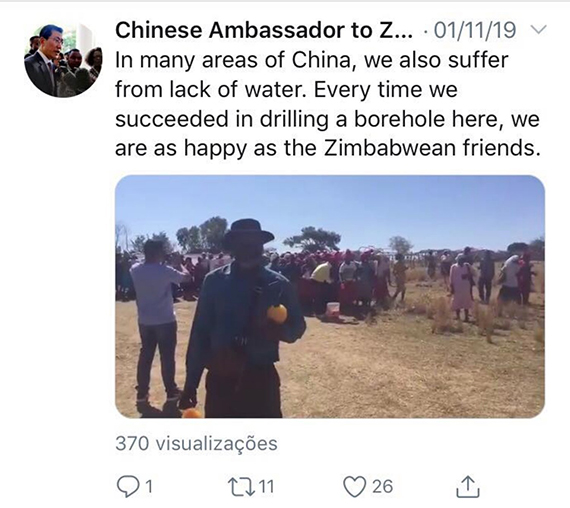
Figure 10 – Twitter post from the Ambassador of the People’s Republic of China to Zimbabwe (November 1, 2019)
China’s ambassador to South Africa follows this line of action and has insisted on strengthening his sense of belonging to South Africa, while stating that, despite being Chinese, he also feels African.
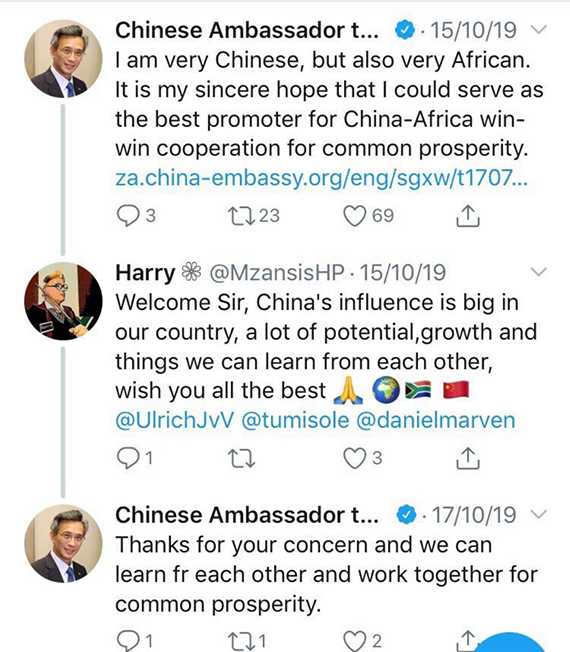
Figure 11 – Interactions via Twitter between the Chinese Ambassador to South Africa and a citizen, on October 17, 2019
It should also be stressed that the examination of Ling Songtian’s Twitter has proven to be interesting in the way the ambassador identifies leaders / people in relevant positions within the African community, while recognizing their importance in shaping public opinion. In this case, China’s ambassador to South Africa offered a digital photo frame made by Aigo, a well-known Chinese company, as a Christmas gift to businessman Nkululeko Mhlaba.
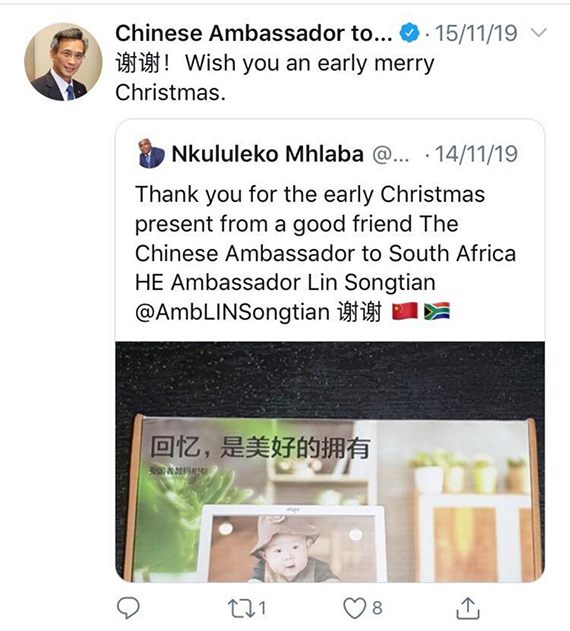
Figure 12 – Interaction between the Ambassador of the People’s Republic of China to South Africa and Nkululeko Mhlaba, on November 15, 2019
Alessandra Cappelletti (June 29, 2019) states that the basis for the Chinese ambassadors' recent sign-up on Twitter comprises an attempt to spread an image of a “friendlier, more approachable and accessible” China in relation to the foreign public. Moreover, Twitter opens up the possibility of two-way communication enabling greater engagement with the target public (Cappelletti June 29, 2019). However, the reality falls well short of that goal. Except for the cases presented, rarely do we see effective dialogue between issuers (ambassadors/embassies) and recipients (African public). While the feedback is present in the posts’ comments, likes and shares, this still remains very minimal. Nevertheless, as concerns the Chinese ambassadors, signing on to Twitter in Africa needs to be regarded as relatively recent, with leeway to expand in the future.
According to Issau Agostinho, in the short and medium term, in order for China to maintain and even enhance its economic vigor, as well as to assert itself on an international scale, that country will continue to further strengthen ties with Africa as long as this continent’s mineral and energy resources remain abundant and relevant for Chinese interests (“Exclusive Interview With Issau Agostinho” November 20, 2019). From Agostinho’s standpoint, this relationship will also evolve and increasingly intensify, while Africa rejects paternalistic attitudes, along with interference in domestic issues by countries from other continents, aiming to destabilize economic and political security (“Exclusive Interview With Issau Agostinho” November 20, 2019). This expert believes that long-term Sino-African relations rely on several domestic and external factors (“Exclusive Interview With Issau Agostinho” November 20, 2019).
Conclusion
The Government of the People’s Republic of China takes advantage of technological advances, in the field of communication, by using the media to internationally project a positive image of the country. The diplomatic corps has made use of the Internet to disseminate the Chinese narrative worldwide, in the sphere of digital public diplomacy.
This work examined the online presence of China’s Embassies in Africa, chiefly with regard to recent signups to social media. As part of this, we highlighted the Twitter accounts of China’s ambassadors to Zimbabwe and to South Africa, given their somewhat close interaction with their followers. Unlike the Facebook accounts of embassies and websites, where the page’s significant number of likes is not indicative of regular interaction between issuers and recipients, the Chinese ambassadors’ communication on Twitter has managed to create some engagement with the public. In part, this phenomenon is explained by adaptation of their discourse to the specificities of the African cultural context, as well as by the use of a simple, informal language. Furthermore, the emotional component must also be taken into account, since this has allowed for greater proximity between the ambassadors and the public. Subsequently, this has contributed toward creating a positive reputation capable of combating certain negative perspectives from the West regarding China.
By virtue of the facts examined herein, we notice obvious interdisciplinarity of the fields of Public Diplomacy and Public Relations and the resulting potential, namely when applied to communications from Chinese ambassadors over the Internet. Even though the presence of these state players on social media is still at a relatively early stage, the success that has been achieved should constitute a driving force for greater investment in these communication platforms, by jointly working with Public Relations experts, particularly within a scenario favorable to strengthening Sino-African ties. All this attests to the strategic importance the Chinese Government attributes to communication in the international sphere.
References
Cappelletti, A, (June 29, 2019). Between Centrality and Re-scaled Identity: A New Role for the Chinese State in Shaping China’s Image Abroad: The Case of the Twitter Account of a Chinese Diplomat in Pakistan. Retrieved 24.2.2020 from
https://www.researchgate.net/publication/334113598_Between_Centrality_and_Rescaled_Identity_A_New_Role_for_the_Chinese_State_in_Shaping
_China's_Image_Abroad_The_Case_of_the_Twitter_Account_of_a_Chinese_Diplomat_in_Pakistan
Chen, X., Liu, X. (2015). Hexin Jiazhiguan Chuanbo De Guojia Gonggong Guanxi Zhanlve Gouxiang [Strategic Conception of National Public Relations for Spreading Chinese Core Values]. Modern Communication, 6 (227), apud Huang, Z., Wang, R. (2019) Building a Network to ‘‘Tell China Stories Well’’: Chinese Diplomatique Communication Strategies on Twitter. Retrieved 10.2.2020 from
https://www.researchgate.net/publication/334129110_Building_a_Network_to_Tell_China_Stories_Well_Chinese_Diplomatic_Communication
_Strategies_on_Twitter
Chinese Embassies – Africa. Retrieved 21.2.2019 from https://www.fmprc.gov.cn/mfa_eng/wjb_663304/zwjg_665342/2490_665344/2493_665350/
Huang, Z., Wang, R. (2019). Building a Network to ‘‘Tell China Stories Well’’: Chinese Diplomatique Communication Strategies on Twitter. Retrieved 10.2.2020 from https://www.researchgate.net/publication/334129110_Building_a_Network_to_Tell_China_Stories_Well_Chinese_Diplomatic_Communication_
Strategies_on_Twitter
Madowo, L. (January 14, 2019). eSwatini – Taiwan’s Last Friend in Africa. Retrieved 21.2.2019 from https://www.bbc.com/news/world-africa-46831852
Olander, E., Mboya, C. (August 16, 2019). China’s New Approach to Public Diplomacy in Africa. Retrieved March 19 from https://chinaafricaproject.com/migrated-posts/podcast-china-africa-kenya-public-diplomacy-soft-power-cliff-mboya/
Shi, C., Shi, Y. (2007). Lun Xinxing Meiti Shidaide Gonggong Chuanbo [Discussing the Public Communication in the Era of New media]. Modern Communication, 4, apud Huang, Z., Wang, R. (2019). Building a Network to ‘‘Tell China Stories Well’’: Chinese Diplomatique Communication Strategies on Twitter. Retrieved 10.2.2020 from https://www.researchgate.net/publication/334129110_Building_a_Network_to_Tell_China_Stories_Well_Chinese_Diplomatic_Communication_
Strategies_on_Twitter
United Nations Regional Groups of Member States. Retrieved 21.2.2020 from https://www.un.org/depts/DGACM/RegionalGroups.shtml
Yi, W. (September 28, 2019). China Today: A Proud Member of the Global Community. Retrieved 17.3.2020 from https://www.facebook.com/chinaemb.ss/posts/1874141436064564?__tn__=K-R
Zhong, X, Lu, J. (December 2013). Public Diplomacy Meets Social Media: A Study of the U.S. Embassy’s Blogs and Micro-blogs. Public Relations Review.
Zhou, Q. (2010). Cong Guoji Yujing Bianqian Dao Huayuquan Tisheng: Shilun Zhongguo Guojia Gongguan De Jiyu Yu Tiaozhan [From the Change of International Context to the Promotion of Discourse Right: The Opportunities and Challenges of China’s National Public Relations]. News and Writing, 10, apud Huang, Z., Wang, R. (2019). Building a Network to ‘‘Tell China Stories Well’’: Chinese Diplomatique Communication Strategies on Twitter. Retrieved 10.2.2020 from https://www.researchgate.net/publication/334129110_Building_a_Network_to_Tell_China_Stories_Well_Chinese_Diplomatic_Communication_Strategies
_on_Twitter
Interviews
“Exclusive Interview with Isabel Ardions” December 1, 2019
“Exclusive Interview with Issau Agostinho” November 20, 2019
“Exclusive Interview with Javier Diéguez Suárez” December 1, 2019
“Exclusive Interview with Nuno Silva” December 3, 2019
Figure 1 / photo by: Jorge Marinho
Published by Marinho Media Analysis / March 29, 2020
http://marinho-mediaanalysis.org/articles/Mar-29-2020/china-in-africa
This article was also published in the University of Southern California Center on Public Diplomacy (CPD) Blog / United States of America / August 14, 2020
https://www.uscpublicdiplomacy.org/blog/china-africa-2019-facebook-twitter-part-public-diplomacy